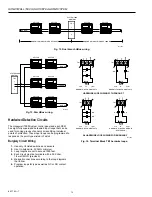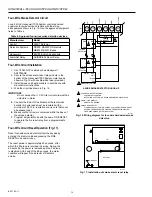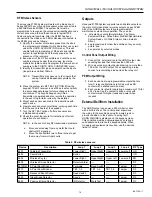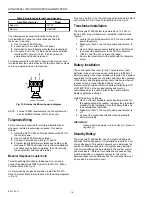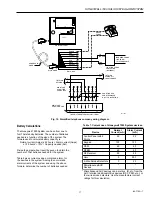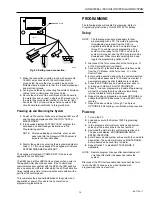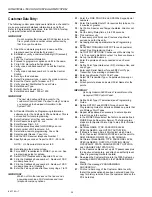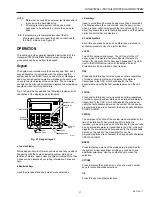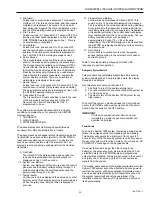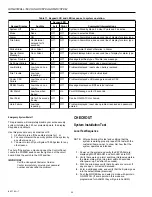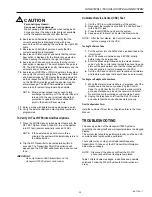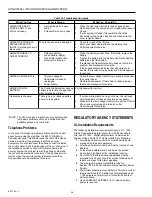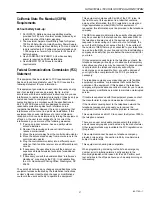
HONEYWELL 7000 SOLID STATE ALARM SYSTEM
69-1192—1
25
CAUTION
Personal Injury Hazard.
Can cause hearing damage.
Wear hearing protection devices when testing bells,
horns or sirens. If hearing protection is not available,
muffle the audible devices until after the test.
6.
Exercise each Perimeter point and verify that the
correct description is displayed along with a one
second tone. When opening the contacts, the right LED
lights.
7.
Exercise each Entry/Exit point and verify that the
correct description is displayed.
8.
Exercise each Interior point and verify that the correct
description is displayed for the interior zone selected.
When opening the contacts, the right LED lights.
9.
Exercise each Fire sensor and verify that the correct
description is displayed. The only hardwire Fire point is
P8. The KEYPAD will alarm locally, immediately and the
external siren or bell turns on.
10.
Exercise any SPECIAL or POLICE points in the system
and verify the correct descriptions. The hardwire Police
and Special loops on TB1 display the same description
as their respective KEYPAD keys. The READY display
on the KEYPAD is replaced with the special or police
alarm message. The KEYPAD audible and outside
siren are both instant if programmed as audible.
NOTE:
After a power outage long enough to fully
discharge the battery, or if the Control Panel is
turned OFF, the user must test all points of
protection to update the status of each RF
point in the Control Panel memory.
11.
Enter a mode with points armed and exercise a point.
12.
Verify the External Bell and output options function as
programmed.
To Verify Or Test RF Points And Descriptions
1.
Press the MODES key, scroll and select number 8, the
RF TEST Option. Press 0, then OK, to put the System
into RF Test (receiver sensitivity reduced 12 dB).
NOTE:
If the next step does not occur in three
minutes, the system will automatically return to
the Default mode.
2.
Trip the RF Transmitter to be tested twice within 8
seconds. The Transmitter Point ID description will
appear, and the KEYPAD will annunciate a one second
tone.
IMPORTANT
Use only Ademco 5800 transmitters on the
Honeywell 7000 System control panel.
1
Customer Service Center (CSC) Test
1.
Call the CSC to coordinate testing of the system.
2.
Reconnect the telephone cord from the Control Panel
to the RJ-31X jack.
3.
Press the MODES key and arm the system.
4.
Cause a point to alarm, and enter the disarm code.
NOTE:
After the first disarm, the Control Panel sends the
restore message to the CSC.
Testing The Duress Code
1.
Put the system into the AWAY mode as described in the
“User Guide”.
2.
Wait 10 seconds in between any KEYPAD activity
before trying the duress code.
3.
Enter the duress digit followed by the master disarm
code. Verify the control panel seizes the phone line and
dials out the police alarm and that the Honeywell 7000
does not send in a restore message to the CSC.
4.
Call the CSC and confirm correct reception of all alarms
and restore messages that should have been received.
Testing Local Telephone Connections
1.
While the dialer communication is in progress, all of the
telephones in the house are seized by the Control
Panel. To verify that the RJ-31X jack is wired correctly,
go to each telephone, pick up the receiver and listen.
No dial tone or other dialing sound should be heard.
2.
Unplug the telephone cord from the RJ-31X module
and ensure that the house phones work properly.
Final Configuration Form
Help the customer fill out the configuration form in the User
Manual.
TROUBLESHOOTING
The security portion of the Honeywell 7000 System is
constantly checking itself and will report problems the Keypad
display.
The system test should be performed locally, and then a CSC
communication test should be performed.
Your system may or may not include radio frequency
transmitters. If it does not, the RF transmitter information
below does not apply.
NOTE:
Disconnect the phone cord from the RJ-31X
phone jack until local testing is completed.
Table 12 lists trouble messages, indications and possible
solutions. Follow the What You Should Do instructions in
order.


